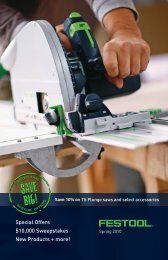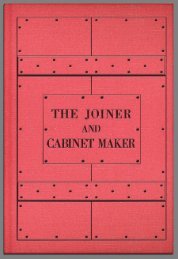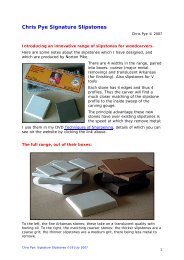WORK: Vol.1-No.51 - Tools for Working Wood
WORK: Vol.1-No.51 - Tools for Working Wood
WORK: Vol.1-No.51 - Tools for Working Wood
You also want an ePaper? Increase the reach of your titles
YUMPU automatically turns print PDFs into web optimized ePapers that Google loves.
8ro. ' '•' .'• •• ; •' .0 ll.R Gui.DE To Goon THINGS.(Work- Mareb 8, 1810.by cementing to mirror glass, and at otherstwo lamps can be judiciously employed <strong>for</strong>the purpose, care being taken to exclude thedirect image of the flame.Respecting the application of the kaleidoscopeto the arts, 1t is difficult to transferthe brilliant colours of some patterns tomaterials of a. sober character, and there<strong>for</strong>eit appears most fitted <strong>for</strong> materials of abrighter and more-reflective character, suchas embroidering, and otherwise orna.mentingin silk, and yet more especially in paper andglass staining and painting; and I cannotconclude these articles in a more excellentway than by quoting a passage from thewritings of the talented discoverer of thekaleidoscope. ·Speaking of the artist who <strong>for</strong>ms windowsof painted glass, he says :-.. In this 'lastprofession,_ in particular, the application ofthe kaleidoscope cannot fail to indicatecombinations far su~rior to anything thathas yet been seen m this branch of art.From the uni<strong>for</strong>mitv of tint in the separatepieces of glass wh1ch are to be combined,the effect produced by the instrument fromportions of the very same glass that is tobe used <strong>for</strong> the windows may be consideredas a perfect fac-simile of the window whenwell executed on a large scale."THE SLIDE VALVE..BY T. R. BLACKETl'.---·~-"LA.P" AND" LEAD "-EccENTRIC SHEAVE.THE slide valve of a steam en~ne has beenso often ably discussed that 1 have almostto apologise <strong>for</strong> writing a -paper upon it.But, however, it is my inteut1on to put thematter so plainly be<strong>for</strong>e my readers, thatmany who read this paper will know howto proceed, should they be called upon toset a slide valve.Very few workmen, who build. . anddraughtsmen who design really high-classengines, are versed in the higher mathematicalbranches, hence my putting it in apracticallight. .The parts of a steam engine move withgeometrical precision with each other; thusevery part must have some angular or linearrelation with each other. Now such beingthe fact, why not do away with the timehonouredthough time-taking custom ofsetting the slide valve be<strong>for</strong>e the eccentricis keyed on to the crank shaft 1 The properungular relation of the eccentric to thecrank is a right angle plus an angle obtainedby the linear advance of ''lap" and"lead."By "lead" is meant· the distance thesteam-post is opened at the commencementof the piston's stroke. By "lap" is meantthe distance the slide valve overlaps theopening ed~e of the steam-post at the endof its travel.Let us take, <strong>for</strong> example, a common Dslide valve (Fig. 1 ). We will suppose thatit ba!i §f-in. " lap," and it is to beset with }-in."lead" on each steam-post, with the travelor stroke of slide valve to be 4 in. We willnow proceed to fix the eccentric, <strong>for</strong> good,in its proper place upon the crank shaft.If a small shaft, we will put it on thesurface plate or marking-off table, lettingit rest in a. pair of V -shaped bars.The next thing to he done is to plumbthe centre of the crank pin directly over thecentre of the crank shaft; having done this,erect a perpendicular line from the bottomof the crank shaft, as shown in Fig. 2; nextthe total "lead" is l in. · set the dividers tothat radius, and mark off from the centre ofthe crank shaft downwards an ·arc cuttingthe perpendicular line a (Fig. 2).Having done this, we take the total" lap,"which is li in.; we set the dividers tothat radius, and mark off downwards asbe<strong>for</strong>e, from where the first arc cuts theperpendicular line to b (Fig. 2). We willnow look to the stroke or travel of the slidevalve itself; we find it is to be 4 in. ; setthe dividers to half that distance, viz.,2 in. Having done so, describe a circlefrom the centre of the crank shaft, which iscalled the travel circle. Here we take thescribing block, or, as some call it, thesurface gauge; set the pointer or scriber at b(.Fig. 2), and draw it along in a horizontaldirection across the end of the shaft until itcuts the travel circle at c (Fig. 2). Nowtake a straight-edge and draw a line fromthe centre of the shaft, o, to the outside ofCR HK----1----f'INl'ig. 2 .Fig.l.0c(....:X:tT·tise.nents.127.-SYElt'll lftTltE BLOCX AN'D SAW.IT will doubtless be fresh in the memory ofmany of my readers that a full description of theapplian ce known as a mitre block, or mitre trap,was given in page 2i3 of this '·olume, and thatits construction, and the mode of making one <strong>for</strong>one's own nse, were clearly uefitled.T o thispaper, " A Mitre Block, and How to M:ake It,"by David Denning, l must there<strong>for</strong>e ~efer ~11who wish <strong>for</strong> more than the necessarily bnefnotice I can give here in reference to ~he1\Iitre Block and Saw, which has lately been Improved-!mny say, perfected-folio~ the..,.cneral lines of the original appliance, and Introducedby 1\fr. Thomas J . Syer, 45, Wilson Street,Finsbury Square, E. C., of the firm of Thomas J.Syer & Co., tool makers, etc., and dealer~! ~n alltools and appliances used in carpentry, JOm~ry,and cabinet mal..'ing, and Principal of the F1_1•~buT"'." Amateur School of Practical Mechan1cs.Th~ mitre block is, as its name impli~, a contrivance<strong>for</strong> mitreing joints, and availabl-: alsoas a means <strong>for</strong> squaring off the ends of p1~sur.h as door-rails, stiles, etc. Mr. ~yer's mttreblock possesses value in being exceptlo~Y ":ellmade,perfectly true, and admirable m adi~ ·••I•The Work Magazine Reprint Project (-) 2012 tools<strong>for</strong>workingwood.com••













